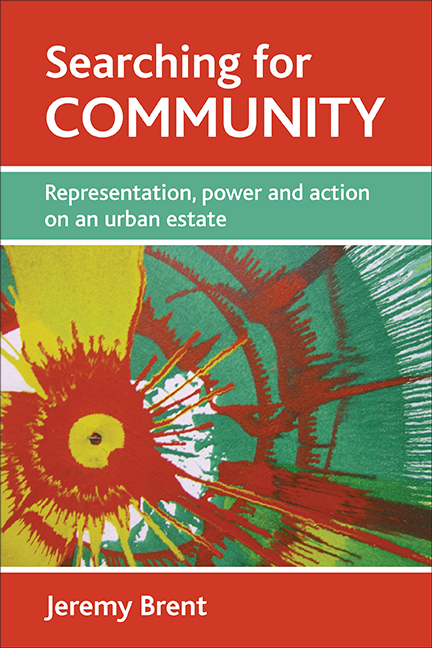Book contents
- Frontmatter
- Contents
- Foreword
- Notes on the author
- Introduction
- one Four settings: contexts and questions
- two Researching Southmead: problems of representation and participation
- three The intelligent outsider? Official and media representations of Southmead
- four Knowledge from within: community art and local representations
- five The outsider within: crossing worlds
- six Young people and community: trouble and tribes
- seven Four examples of community action in Southmead
- eight What is community anyway?
- nine Engaging with community
- ten Communicating what youth work achieves: the smile and the arch
- Author’s acknowledgements
- Epilogue: Southmead eight years on
- Afterword: Why Jeremy Brent’s work is more relevant than ever
- Bibliography
- Index
two - Researching Southmead: problems of representation and participation
Published online by Cambridge University Press: 22 January 2022
- Frontmatter
- Contents
- Foreword
- Notes on the author
- Introduction
- one Four settings: contexts and questions
- two Researching Southmead: problems of representation and participation
- three The intelligent outsider? Official and media representations of Southmead
- four Knowledge from within: community art and local representations
- five The outsider within: crossing worlds
- six Young people and community: trouble and tribes
- seven Four examples of community action in Southmead
- eight What is community anyway?
- nine Engaging with community
- ten Communicating what youth work achieves: the smile and the arch
- Author’s acknowledgements
- Epilogue: Southmead eight years on
- Afterword: Why Jeremy Brent’s work is more relevant than ever
- Bibliography
- Index
Summary
Introduction
In Chapter One, I referred to how the intended representation of Southmead in the film Rush changed through the filming and editing process, with the community-oriented street scenes not reaching the final cut. While the film started off as a community film project, in its final version it is a celebration of individualism. The publicity blurb states: ‘At night a proud young man sits on the estate. He doesn't need to follow the crowd …’. The making of this film shows how the desire to create a coherent and intelligible story for an audience changed the depiction of the area in the final work. The editorial argument was that ‘the street scenes did not work cinematically’.
Writing as a method of representation also carries with it the desire of the author to create an intelligible and coherent text. It, too, transforms its material as it turns it into words on a page, which is what gives writing its excitement, just as film making is exciting. It is important to be aware that this transformation is not neutral, and there are three particular reasons why I consider the question of writing, or any form of representation, to be so important to this book. First, there is a battle of representation, which plays a crucial role in the history of Southmead. Southmead and its young people are the subject of a range of contested representations, with representations themselves becoming major areas of conflict. ‘Outsider’ representations of Southmead, for example in the press, or ‘insider’ representations, as in the community play of 1994, have all been the subject of strong feelings and fierce debate. Outsider representation is often perceived as one of the oppressions from which its inhabitants suffer, a subject I will return to in the next two chapters, when I look at the issues of the external gaze and community expression, and this recurrent insider/outsider motif.
The second reason for being concerned about the representation ‘of ‘ Southmead is the way that such representations channel the direction of enquiry. Most representations, in delineating problems that can be attached to the geographical area of Southmead, cast Southmead itself as a problem, and there are many examples of this approach. However, in these representations what Southmead is as a phenomenon is never considered.
- Type
- Chapter
- Information
- Searching for CommunityRepresentation, Power and Action on an Urban Estate, pp. 33 - 66Publisher: Bristol University PressPrint publication year: 2009



